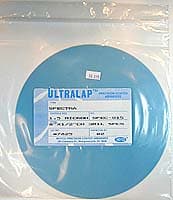Spectra (Ultralap) Lap
Jeff R Graham shares his opinions and thoughts on various topics in Just Ask Jeff. See his answer to What is a Spectra (Ultralap) Lap? How do I use them?
3 Minute Read
Spectra (Ultralap) Lap
Ultralaps are a plastic polymer sheet of film (3 mil) that come in 6″ or 8″ diameter.
They are charged with a very high grade of oxide polish. They come in quite a few polish types, AeO2 aluminia oxide , CeO2 cerium oxide, chrome oxide, tin oxide, and spectra (high grade CeO2).
I only use the spectra Ultralaps.
Although I know people who have good luck with the others. I think that the specta Ultralaps in particular are ideal for putting a final polish on Quartz and Beryl. I have not found anything as convenient or better than these are for just popping in the final polish, especially on Quartz.
Notice I said final polish. It is important that you have a good quality pre-polish with Quartz. I recommend that you use a Nu bond 1200 composite lap or a 3,000 grit lap for pre-polishing both Beryl and Quartz, this lap is ideal for them. However, because these laps leave so fine a pre-polish on the facets, they tend to leave some orange peel on other materials like Tourmaline and Garnets and I do not use it for these materials. Especially the Nu Bond 1200 lap.
The Nu Bond 1200 completely eliminates that odd random scratch that steel (diamond) laps tend to leave on Quartz. If you have had this problem, then you know what I am talking about.
Ultralaps are easy to use. You will need to use another lap or a master lap to place the thin Ultralap film onto. Polish is on the dull side.
I use my Nu Bond 1200 lap as the base for my Ultralaps, because I figure that if I pre-polished with it then the settings will be the same (no cheat is required). I just use water, some people use a little bit of dish soap in their water to help make a good seal between the lap and the master lap. It is very important to not only have a good seal between the Ultralap and base lap, it is important to make sure make sure that there are no air bubbles that might weaken the seal, or make the Ultralap slip loose.
Below are pictures of a Spectra Lap being placed on my Nu Bond 1200.
Easy does it. The biggest mistake that most people make when using an Ultralap is that they use too much pressure.
Too much pressure will make the stone you are trying to polish dig into the lap. Often gouging the Ultralap and damaging it, when you do. Once you have gouged the lap it will kind of skip and bump in that particular spot. The lap is still usable, just use the good areas left.
The secret to long life and good polishing with an Ultralap, is to not gouge or beat it up and recharging the lap as you are polishing (see below). Too much pressure will also cause the facets to round. Also too much pressure sometimes will create a wrinkle in your polish on the face of the facet.Light but firm pressure with a gently sweeping motion across the lap is the best method.Once you have used an Ultralap a few times you will get the hang of using them, it is not hard.
Recharge you Spectras. I always use cerium oxide mixed with water (about the consistency of whole milk) and charge my laps as I am polishing. Doing this will extend the life of your Ultralaps tremendously, I often use the same one for months, and polish a lot of stones with a single lap.
Do not forget that you can use alumina oxide on a spectra lap too. I find that a Spectra charged with alumina oxide is a great way to eliminate those little horse hair scratches that I get once and a while when polishing Tourmaline on a tin lap.
Sometimes when polishing a piece of Tourmaline or Garnet, there just seems to be a facet or two that does not want to polish all the way. A Spectra lap charged with alumina oxide will almost always solve the problem.
Note: Do not to mix the oxide polishes on the same Ultralap, I use separate Ultralaps for each polish and store them seperately.
Jeff R. Graham
The late Jeff Graham was a prolific faceter, creator of many original faceting designs, and the author of several highly-regarded instructional faceting books such as Gram Faceting Designs.
Related Articles
Basic Rules for the Gem Cutting Business
How to Use a Color Wheel for Gem Faceting
Commercial and Rough Stone Prices
How to Cut a Simple Portuguese Gem Design
Never Stop Learning
When you join the IGS community, you get trusted diamond & gemstone information when you need it.
Get Gemology Insights
Get started with the International Gem Society’s free guide to gemstone identification. Join our weekly newsletter & get a free copy of the Gem ID Checklist!
